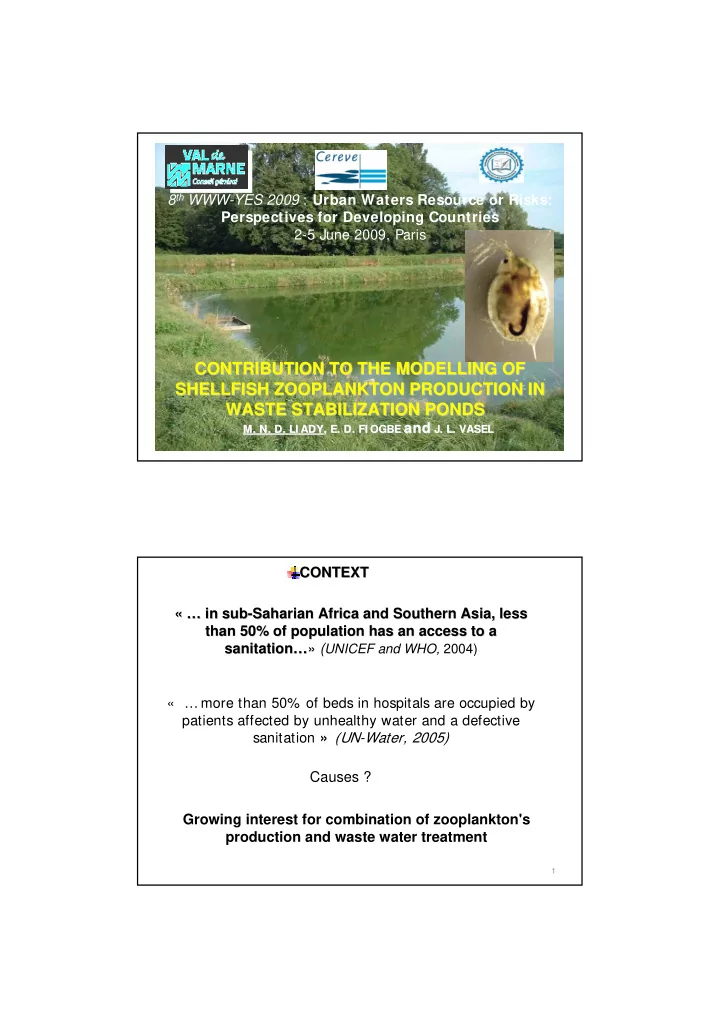

8 th WWW-YES 2009 : Urban Waters Resource or Risks: Perspectives for Developing Countries 2-5 June 2009, Paris CONTRIBUTION TO THE MODELLING OF CONTRIBUTION TO THE MODELLING OF SHELLFISH ZOOPLANKTON PRODUCTION IN SHELLFISH ZOOPLANKTON PRODUCTION IN WASTE STABILIZATION PONDS WASTE STABILIZATION PONDS and J. L. VASEL , E. D. FI OGBE and M. N. D. LI ADY, E. D. FI OGBE J. L. VASEL M. N. D. LI ADY 0 CONTEXT CONTEXT « « … … in sub in sub- -Saharian Africa and Southern Asia, less Saharian Africa and Southern Asia, less than 50% of population has an access to a than 50% of population has an access to a sanitation… sanitation … » » ( UNICEF and WHO, 2004) « … more than 50% of beds in hospitals are occupied by patients affected by unhealthy water and a defective sanitation » (UN-Water, 2005) Causes ? Growing interest for combination of zooplankton's production and waste water treatment 1
OBJECTIVES : Seek available data for modelling OBJECTIVES : Wind Sun PHYTOPLANKTON WASTE WATER Stoichiometry, kinetic, [CO 2 ] ZOOPLANKTON Mineral matter Kinetic, Stoichiometry Load [O 2 ] BACTERIA Stoichiometry, kinetic, Organic Matter Load 2 Outline Various types of Wastewater Stabilisation Ponds (WSP) Zooplanktons of WSP Available data Conclusion and Prospects 3
WSP types WSP types TYPE OF WASTE STABILIZATION CHARACTERISTIC Facultative Anaerobic High-rate algal S Aerated WSP WSP pond pond Aerobic Very few or not strong algal algae Biological bacteria algae , biomass, bacteria, component Few algae , Anaerobic bacteria, little zooplankton Zooplankton Bacteria zooplankton Photosynthesis Mechanical Diffusion with Aerators (paddle Airing mode Diffusion water- aerators or the water-air wheel) or air interface Blowers interface Blowers Flow Flow Mixing mode Mechanics Paddle wheel Wind Wind Sedimentation, Sedimentation Aerobic, anoxic Aerobic Degradation Aerobic Purification and anaerobic degradation, mainly degradation, mechanism degradation Predation anaerobic, Predation Predation Predation 4 The zooplankton of WSP The zooplankton of WSP The zooplankton of WSP The zooplankton of WSP PROTOZOA Rhizopodes Rhizopodes Flagellate 5
The zooplankton of WSP The zooplankton of WSP ROTIFERS CLADOCERS Philodina Daphnia magna 6 ponds ' zooplankton Wastewater ponds ' zooplankton Wastewater COPEPODS Copepoda, Cyclops sp 7
Available data Factors influencing daphnids activity � food � food non exclusive Food Detoxication BACTERIA BACTERIA Provision of chemical substances 8 Available data factors influencing daphnids activities Food (non gathered) ALGAE ALGAE Obstruction of apparatuses filterers (big size) Toxic substances release ~80% food PARTICULATE ORGANIC MATTERS PARTICULATE ORGANIC MATTERS AND NANOFLAGELLATE AND NANOFLAGELLATE (CAUCHIE, 2000) 9
Factors influencing daphnids activities � Environmental physico � Environmental physico- -chemical conditions chemical conditions [NH 3 ] 48h 24h Source: HATHAWAY et STEFAN (1995) 10 Factors influencing daphnids activities � Environmental physico � Environmental physico- -chemical conditions chemical conditions Temperature Growth and production kinetics [O 2 ] Species selection Help for increasing contribution to water treatment and its probable production 11
Existing models on zooplankton Daphnid R.W.Q.M. n ° 1 Comparison criteria population (IWA task group, (HATHAWAY and 2001) STEFAN, 1995) Ponderal - + Parthenogenetic + + Growth Sexual + - reproduction Toxic effect + - Death + + Disappear Endogenous ance + + respiration Predation + - Clearing out of pond + - Sedimentation + - Organic particulate matters - + Algae + + Bacteria - + 12 Order of magnitude concerning ingestion and filtration rate Ingestion Ingestion Species Filtration rate rate (% of Substrate rate (% of /Condition (en L.m -2 .day -1 ) production/j Biomass /day) ) 2233.3 to 3137.3 66 to 92 2 to 90 Phytoplan (including Daphnia (including 171 (including kton 5816.5 in July) magna / in) 310 in July) aerated WSP 4 to 599,9 Bacteria 0.1 to 17,6 0,8 to 226 Experimental 134,4 E-coli - - conditions millions / hour 13
Data on identified expressions S − β ( T T ) O 0 k e 2 X X CON + gro , CON , T i CON 0 K S O , CON O 2 2 Diversity of expressions and units α S O O e 2 2 − 1 α ξ + S O O e 2 2 O 2 14 CONCLUSION AND PERSPECTIVES CONCLUSION AND PERSPECTIVES � Orientations given by these Data � WSP adapted to Southern countries contexts � Zooplankton production in WSP all over the year � Two complementary models exist � Some data on kinetics of northern species 15
Recommend
More recommend